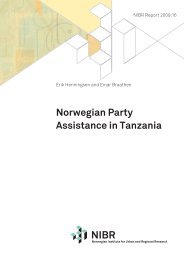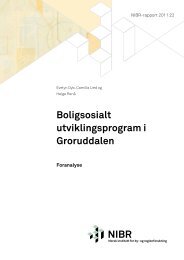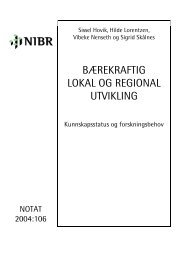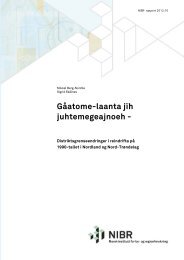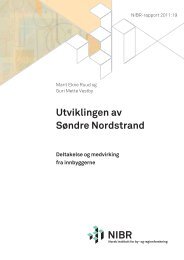http://www.tandfonline.com/page/terms-andconditions
The special importance of housing policy for ethnic minorities ...
The special importance of housing policy for ethnic minorities ...
- No tags were found...
You also want an ePaper? Increase the reach of your titles
YUMPU automatically turns print PDFs into web optimized ePapers that Google loves.
8 H. Skifter Andersen et al.Downloaded by [Norsk Institutt for By og] at 07:07 11 March 2013Instead of social/public housing, Norway has historically focused on cooperative housingas housing for middle- and low-in<strong>com</strong>e groups. Today, prices for cooperative housing inthe metropolitan region have increased to the same level as homeownership. The main supportis to supply low-in<strong>com</strong>e households with subsidised state loans and housing allowancesin order to be able to buy and keep a dwelling, regardless of the nature of ownership. Thecooperative sector is of very little importance in Finland and forms only a small sector inDenmark. Sweden has the largest cooperative sector. It can to some extent be seen as asubstitution for owner-occupied flats, which to a limited extent exist in Sweden, and theaverage in<strong>com</strong>es in the sector are above average (see Table 5). The history of cooperativesin Norway and Sweden is somewhat similar and in both countries the sector is dominated bylarge housing associations. Cooperatives in Denmark are quite different. They have mostlybeen converted from private renting and been subject to a strict price control, which has tosome extent been lifted in recent years.Overall, the rental sector is largest in Denmark with about 40% followed by Swedenwith 30%, Finland with 30% and Norway with 23%.In all of these countries private renting has been declining over time in both absoluteand relative size. In Denmark and Norway, it is still about one-fifth of the stock, while inSweden it now accounts for 15% of dwellings and in Finland 14%. There are, however,marked differences between the countries, concerning the conditions for private renting.Denmark still has a strict rent control; Sweden has a modest control; while rents in Norwayand Finland are determined by the market. In Denmark and Sweden, rent regulation to someextent results in rents below market rents. This is especially the case in Denmark, whererents are very differentiated with at the same time very low rents in part of the market andvery high rents in others.The size of the owner-occupied sector differs somewhat as a more or less direct effectof housing policies. Norway and Finland have the largest sectors (62 and 59% respectively).In Denmark and Sweden, owner-occupied housing accounts for somewhat more than halfof the stock. However, if cooperatives are viewed as a kind of owner-occupation, Norwayhas the largest share with 76% followed by Sweden with 70%.The <strong>com</strong>position of tenures in some neighbourhoods with low quality or low-cost housing,which immigrants have had an easy access to, has to some extent initiated the processof segregation of immigrants. In turn, this has influenced immigrants’ choice of tenuresand their housing situation. The first immigrants to Denmark, Norway and Sweden tendedto settle in older neighbourhoods in cities, dominated by private renting. This has especiallybeen the case in Norway. Over the course of time, immigrant-dense neighbourhoodsin Denmark, Finland and Sweden emerged in areas dominated by social/public housing.In Norway, immigrant-dense neighbourhoods developed in areas dominated by cooperatives.As described in the theoretical section, there is evidence from countries such asSweden and the United States (Bramå, 2006; Wright et al., 2005) that immigrant-denseneighbourhoods tend to attract more immigrants due to white flight and avoidance, andto some extent due to preferences for ethnic enclaves. It is therefore to be expected thatsegregation has increased the presence of immigrants in social/public housing in Denmark,Finland and Sweden, while in Norway it has been important for immigrants’ settlement incooperatives.Evaluation of housing affordability in the countriesImmigrants most often belong to low- and moderate-in<strong>com</strong>e groups. Of decisive importancefor immigrants’ housing options is their ability to pay housing costs and to get loans for



